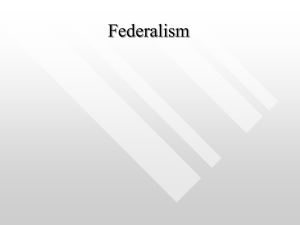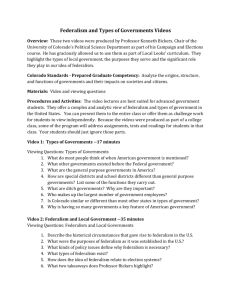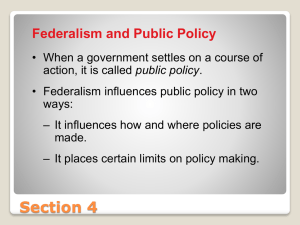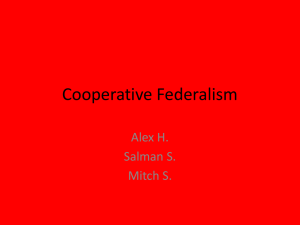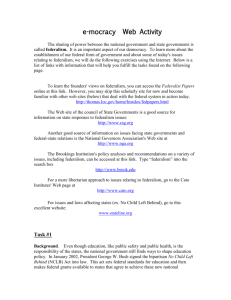The Challenges of Modern Federalism
advertisement
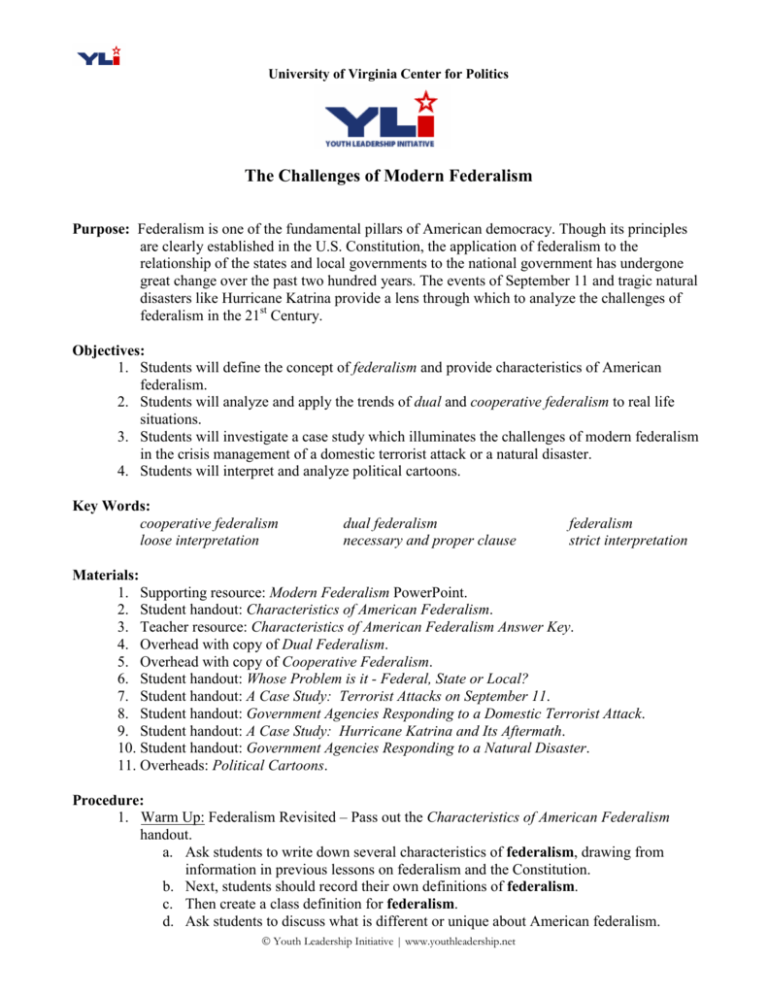
University of Virginia Center for Politics The Challenges of Modern Federalism Purpose: Federalism is one of the fundamental pillars of American democracy. Though its principles are clearly established in the U.S. Constitution, the application of federalism to the relationship of the states and local governments to the national government has undergone great change over the past two hundred years. The events of September 11 and tragic natural disasters like Hurricane Katrina provide a lens through which to analyze the challenges of federalism in the 21st Century. Objectives: 1. Students will define the concept of federalism and provide characteristics of American federalism. 2. Students will analyze and apply the trends of dual and cooperative federalism to real life situations. 3. Students will investigate a case study which illuminates the challenges of modern federalism in the crisis management of a domestic terrorist attack or a natural disaster. 4. Students will interpret and analyze political cartoons. Key Words: cooperative federalism loose interpretation dual federalism necessary and proper clause federalism strict interpretation Materials: 1. Supporting resource: Modern Federalism PowerPoint. 2. Student handout: Characteristics of American Federalism. 3. Teacher resource: Characteristics of American Federalism Answer Key. 4. Overhead with copy of Dual Federalism. 5. Overhead with copy of Cooperative Federalism. 6. Student handout: Whose Problem is it - Federal, State or Local? 7. Student handout: A Case Study: Terrorist Attacks on September 11. 8. Student handout: Government Agencies Responding to a Domestic Terrorist Attack. 9. Student handout: A Case Study: Hurricane Katrina and Its Aftermath. 10. Student handout: Government Agencies Responding to a Natural Disaster. 11. Overheads: Political Cartoons. Procedure: 1. Warm Up: Federalism Revisited – Pass out the Characteristics of American Federalism handout. a. Ask students to write down several characteristics of federalism, drawing from information in previous lessons on federalism and the Constitution. b. Next, students should record their own definitions of federalism. c. Then create a class definition for federalism. d. Ask students to discuss what is different or unique about American federalism. Youth Leadership Initiative | www.youthleadership.net NOTE: See teacher resource Characteristics of American Federalism – Answer key for sample answers. 2. Federalism and Betty Crocker: Layer Cake v. Marble Cake Federalism – Project via the supporting PowerPoint Modern Federalism or overhead both Dual Federalism (layer cake) and Cooperative Federalism (marble cake). a. Define each term and ask students to provide examples. b. Question for Discussion: What does dual and cooperative federalism have in common with layer and marble cakes? In the dual-layer cake analogy, the chocolate icing represents the federal government and the yellow cake is the state government. In this design, the federal and state government have very defined powers and duties which seldom overlap (for instance, only the states regulate public schools, only the federal government handles foreign affairs). The state government has almost equal power to the federal government. In the cooperative-marble cake analogy, the federal government is acutely more powerful than the states and its authority has shifted into areas historically left to the states (education, social welfare, response to natural disasters). c. Optional: For more in-depth study and/or for higher level students, pass out and discuss the student handout Key Events in the History of American Federalism. 3. Making Connections: Whose Problem is it - Federal, State or Local? – Pass out the student handout Whose Problem is it - Federal, State or Local? Divide the class into small groups. The four scenarios are based on real life situations. Each group must address the problems and decide which level of government or combination thereof, would best handle the problem, and complete the following tasks: a. Identify what tasks need to be carried out to address the problem. b. Identify what level(s) of government, federal, state or local, is responsible and/or best equipped to resolve the problem. c. Provide clear rationale for each of your choices. 4. Case Studies: Federalism and Crisis Management – Perhaps the greatest challenge to modern federalism in the 21st Century is the effective response on all levels of government to a domestic terrorist attack or natural disaster. Teachers may choose either the terrorist attacks on 9-11 or the aftermath of Hurricane Katrina (or both) as case studies in federalism. (Note: Teachers may also adapt/edit the “real life” scenarios provided here to be more generic hypothetical cases). a. Pass out either the student handout A Case Study: Terrorist Attacks on September 11 and its corresponding student handout Government Agencies Responding to a Domestic Terrorist Attack or the student handout A Case Study: Hurricane Katrina and Its Aftermath and its corresponding handout Government Agencies Responding to a Natural Disaster. b. Begin the role play. 5. Wrap-up: Political Cartoons – Project the political cartoons via the supporting PowerPoint Modern Federalism or using the overhead. Ask students to interpret the cartoons. Ask the following questions: • Describe what’s going on in the political cartoon (Who? What? When? Where?) • Identify any symbols (ex: an elephant to represent the Republican Party) portrayed in the cartoon and analyze what they represent. Youth Leadership Initiative | www.youthleadership.net • • • What is the artist’s message in the cartoon? What do you think is its purpose? Do you agree or disagree with the cartoonist's message? Explain your answer. What does this cartoon say about federalism and crisis management? Appendix: Modern Federalism PowerPoint teacher resource includes many of the important content elements of the lesson. Youth Leadership Initiative | www.youthleadership.net Student Handout FEDERALISM Federalism - Youth Leadership Initiative | www.youthleadership.net Teacher resource – Answer key National government is supreme Federal, state & local governments share power 10th Amendment – powers reserved to the states FEDERALISM Federal Govt. has expressed powers (tax, declare war, etc.) Federal Govt. has implied powers (necessary & proper clause) Limited government states check power of federal govt. Federalism – a system of government in which political authority is divided between a national, or federal, government, and its political subdivisions. In this system, national and state govt’s each have defined powers, with some being shareInitiative by both and some being denied both. Youth Leadership | www.youthleadership.net Overhead Dual Federalism “layer cake” federalism dual federalism - holds that the federal government and the state governments are co-equals, each sovereign. o In this theory, parts of the Constitution are interpreted very narrowly, such as the 10th Amendment, the Supremacy Clause, the Necessary and Proper Clause, and the Commerce Clause. o In this narrow interpretation, the federal government has jurisdiction only if the Constitution clearly grants such (examples: coining money, regulating commerce, foreign affairs). o In this case, there is a very large group of powers/roles belonging to the states, and the federal government is limited to only those powers explicitly listed in the Constitution (examples: education, race relations). o This type of federalism dominated from the Founding (1788) to FDR’s election in 1932. o What does dual federalism have in common with a layer cake? Youth Leadership Initiative | www.youthleadership.net Overhead Cooperative Federalism “marble cake” federalism cooperative federalism - asserts that the national government is supreme over the states with the federal government intervening or assisting in some areas that have been traditionally left to the states o The 10th Amendment, the Supremacy Clause, the Necessary and Proper Clause, and the Commerce Clause should be interpreted loosely. o A good illustration of the wide interpretation of these parts of the Constitution is exemplified by the Necessary and Proper Clause's other common name: the Elastic Clause. o Current trend in federalism since the New Deal in the 1930s. o Examples of federal and state governments sharing power previously left to the states: education, social programs, transportation, civil rights, response to national emergencies. o What does cooperative federalism have in common with a marble cake? Source: http://www.usconstitution.net/consttop_fedr.html Youth Leadership Initiative | www.youthleadership.net Student handout Key Events in the History of American Federalism I. Dual Federalism 1801-1835 Nationalist Period. The Marshall Court dramatically increased the power of the federal government in relation to the states. McCulloch v. Maryland (1819) landmark court case establishing Congress’s establishment of a national bank using the “elastic clause.” 1835-1861 Dual Federalism and Nullification. Strong emphasis on states’ rights (Ex.: South Carolina’s Doctrine of Nullification re: the tariff and slavery. The Supreme Court becomes increasingly uncomfortable with the issue of federalism and slavery (Dred Scott Decision, 1857). 1861-65 American Civil War. The North’s victory determines that the federal government and constitution will reign supreme. However, the war does not resolve the conflict between federal and state authority. Battles will be fought over authority in voting eligibility, school desegregation, and caring for the nation’s poor. Morrill Act (1863) - 1st federal grants for land grant universities (e.g. VA Tech) 1876-1954 Jim Crow Laws. According to the original Constitution, states could determine voting eligibility. Southern states denied blacks their voting rights for many years until the federal government enforced the 14th, 15th amendments with force. Plessy v. Ferguson (1896) legalizes segregation. II. Cooperative Federalism 1933-1939 Introduces FDR the “New Deal.” In response to widespread poverty and unemployment, Roosevelt Administration responds through a series of sweeping national programs such as social security, public works programs, etc. The Supreme Court eventually confirmed FDR’s right to actively intervene in areas traditionally left to states on the basis of the federal government’s Constitutional Right to regulate interstate commerce (Article I, Section 8 “elastic clause”). 1954 Brown v. Topeka Board of Education. The Supreme Court mandated school integration. The southern states decry what they see as the federal government’s intrusion on traditional states’ rights. 1957 Little Rock, Arkansas. Arkansas Gov. Orval Faubus orders State National Guard to prevent black students from enrolling at all white Central High School. President Eisenhower responds by ordering federal troops to protect the black students and to enforce the Supreme Court’s Brown decision. 1964-1968 LBJ and the “Great Society.” Johnson administration introduces a far-reaching domestic program to fight poverty and civil rights violations. LBJ administration enacts Medicaid and other programs which involve Federal oversight of state governments. Youth Leadership Initiative | www.youthleadership.net 1970 Nixon Administration Builds on “Great Society.” New federal programs continue the expansion of the federal power over states and localities. Clean Air and Water Acts are enacted in the form of direct orders. Others are funded through “block grants” which give states more discretion over spending. 1980s Reagan and “New Federalism.” Reagan attempts to limit the powers of the federal government to impose its policies on state governments -- Devolution. However, as the budget deficit begins to soar, the ability of the national government to fund state programs becomes limited. Mandates like the Americans with Disabilities Act are unfunded. 1990s Clinton Administration Declares “The era of big government is over.” Clinton and a Republican dominated Congress shift the responsibility of welfare away from the federal government to the states in the form of block grants with strings attached. 2000s George W. Bush and the “9-11 Era.” Greater federal control over law enforcement, education, and security (examples No Child Left Behind Act, USA Patriot Act). Youth Leadership Initiative | www.youthleadership.net Student handout Whose Problem is it - Federal, State or Local Government? The problems faced by all levels of government in modern life can be staggering and even overwhelming. Below are four scenarios that are based on real life situations. You groups task is to address the problems and decide which level of government or combination thereof, would best handle the problem. Directions: Read each scenario carefully and address the following: 1. Identify what tasks need to be carried out to address the problem. 2. Identify what level(s) of government, federal, state or local, is responsible and/or best equipped to resolve the problem. 3. Provide clear rational for each of your choices. Scenario 1 The Chattahoochee river near Atlanta, Georgia has become polluted from industrial pollution, human waste and debris. The city has so far been unable to effectively clean the river. As a result, the fish are dying, the river is trash infested, water has turned a brownish color, and stench from the river has caused nearby residents to complain. This polluted water has begun to contaminate drinking water in the city. Whose problem is it? Scenario 2 The District of Columbia's public school buildings are in poor condition. Buildings are old and falling apart, roofs are leaking, air, heat, and sewer systems need repair. The problem is so bad, schools did not open on time. National standardized test scores of DC students are some of the lowest in the country, and many of the District’s schools are in non-compliance with No Child Left Behind. Yet because of the building problems, curriculum development and improvement is now last on the priority list for DC public schools. Whose problem is it? Scenario 3 In many American cities , the AIDS crisis continues with a disproportionate number of new infections greatest among the poor. The African-American community in particular has been hit hard by the AIDS epidemic (41% of all AIDS cases in the U.S.), with Black women emerging as the highest at risk group. AIDS is the second leading cause of death for Americans between the ages of 25 and 44. Whose problem is it? Source: http://www.mba.wfu.edu/futurefocus/winter2001f9.html Scenario 4 A major earthquake has erupted near Los Angeles, California causing widespread damage. Sections of major freeways collapsed, parking structures and office buildings collapsed, numerous apartment buildings suffered irreparable damage, over 1 million people without power and water, with hundreds feared dead or injured. Whose problem is it? Youth Leadership Initiative | www.youthleadership.net Student handout A Case Study: Terrorist Attacks on September 11 Federalism and Crisis Management Directions - The awesome and terrible events of September 11, 2001 in New York and Washington elicited a multitude of responses from the federal, state and local governments. This activity will allow you to get a real sense of the "marble cake" image of federalism as well as to develop an understanding of the choices that government leaders have to make. Particularly in crisis situations, the levels of government must sometimes depend on each other. As a class, we will brainstorm all the tasks the governments at the local, state and federal levels are facing in the wake of this tragedy, and devise strategies to attack the crisis. 1. The class will be divided into small groups of three. Group members should share their thoughts and compile three lists: 1) the tasks the national government must perform, 2) those of the state governments, and 3) the city/locality’s responsibilities. 2. We will then divide into "government level" groupings. The original groups (triads) will send one representative to each of the following "government level" groups: 1) federal government, 2) state government (NY in particular), and 3) local government. At this point, the government level groups will discuss the tasks to be performed and produce a chart with five headings: a. Prioritized list of tasks (before, during, and after the attacks) b. Responsible agencies and organizations c. Private or non-profit organizations involved or needed d. Resources required e. Anticipated problems and recommendations to fix them 3. Presentations: Each government group will present their findings to the rest of the class. Other groups may ask questions and make comments. 4. Debriefing: After the presentations, the class will discuss the questions below. a. Identify the tasks that most be shared by all three levels of government. How should coordination occur to carry out these tasks (i.e. who’s in charge)? b. Identify the tasks that could/should only be carried out by the local, state or federal governments. c. What generalizations can you make regarding a domestic terrorist attack and it’s impact on American federalism? d. As an “expert” representing your level of government, if you were asked to testify before Congress, what recommendations would you make to assist in America’s preparedness in the future for a terrorist attack? Youth Leadership Initiative | www.youthleadership.net Student handout Government Agencies Responding to a Domestic Terrorist Attack Federal Government (includes the President, White House Staff, Cabinet Secretaries, Congress, Independent Agencies) Bureau of Alcohol, Tobacco and Firearms and Explosives – Investigates and enforces federal laws and regulations regarding firearms, explosives and arson. Central Intelligence Agency – Obtains and analyzes information about foreign governments, corporations, terrorist cells and individuals. Department of Defense – Coordinates military response and assists FEMA and National Guard after a terrorist attack for security. Department of Health and Human Services - Deploys U.S. Public Health Service Officers to effected areas on standby for deployment to support medical response. Department of Homeland Security – Protects American people from harm and its property from damage, and manages federal assistance and provides resources to effected areas. Department of Labor – provides disaster unemployment assistance and National Emergency Grants and assists in job recovery programs. Department of State – Communicates with other countries and international organizations like the U.N. to coordinate assistance and foreign cooperation through diplomatic channels. Federal Bureau of Investigations – Acts as the federal police force whose primary purpose to detect and investigate crimes against the United States. Federal Emergency Management Agency (FEMA) – Provides supplies, equipment, financial assistance to victims and Disaster Medical Assistance Teams to areas domestic terrorist attacks. National Security Agency – Collects and analyzes message communications. Secret Service – Provides primary protection for the President, Vice-President and high ranking government officials. U.S. Coast Guard – Provides aircraft, patrol boats and cutters to conduct search, rescue and humanitarian aid operations. State Government (includes the Governor, State Legislatures and Agencies) National Guard – Though a federal entity, may be called by governors to provide search and rescue, assisting local law enforcement, and supplies to victims. State Department of Health – assists in disease control, and management of public health crisis in effected areas. State Emergency Management Agencies – helps to coordinate shelters, supplies, health care, transportation for recovery efforts. State Police – state law enforcement. Local Government (includes Mayors, Municipal or County Boards or Councils, Agencies) Local Emergency Services – first responders to medical emergencies. Local Fire Department – first responders to carry out search and rescue operations. Youth Leadership Initiative | www.youthleadership.net Local Law Enforcement – police, sheriff departments with primary law enforcement responsibility. Local Public Transportation (buses, trains, subways) – transportation for possible evacuation. Social Services – provides assistance to families, individuals in need. Private or Non-Profit Organizations American Red Cross – provides temporary shelter, supplies, relief workers and support to disaster victims. The Salvation Army - provides services (food, clothing, etc.) to survivors and first responders in the effected areas. Sources: http://www.firstgov.gov http://en.wikipedia.org/ Youth Leadership Initiative | www.youthleadership.net Student handout A Case Study: Hurricane Katrina and Its Aftermath Federalism and Crisis Management Directions - The awesome force and powerful destruction of Hurricane Katrina on August 29, 2005 left much of the Gulf Coast in ruin and precipitated an almost unprecedented national emergency, particularly in the city of New Orleans. The events before, during and after the hurricane elicited a multitude of responses from the federal, state and local governments. This activity will allow you to get a real sense of the "marble cake" image of federalism as well as to develop an understanding of the choices, sometimes very difficult ones, that government leaders have to make. Particularly in crisis situations, the levels of government must sometimes depend on each other. As a class, we will brainstorm all the tasks the governments at the local, state and federal levels are facing in the wake of this tragedy, and devise strategies to attack the crisis. 1. The class will be divided into small groups of three. Group members should their thoughts and compile three lists: 1) the tasks the national government must perform, 2) those of the state governments, and 3) the city/locality’s responsibilities. 2. We will then divide into "government level" groupings. The original groups (triads) will send one representative to each of the following “government level” groups: 1) federal government, 2) state government (Louisiana and Mississippi in particular), and 3) local government (especially New Orleans, LA and Biloxi, MS) At this point, the government level groups will discuss the tasks to be performed and produce a chart with five headings: a. Prioritized list of tasks (before, during, and after the attacks) b. Responsible agencies and organizations c. Private or non-profit organizations involved or needed d. Resources required e. Anticipated problems and recommendations to fix them 3. Presentations: Each government group will present their findings to the rest of the class. Other groups may ask questions and make comments. 4. Debriefing: After the presentations, the class will discuss the questions below. a. Identify the tasks that most be shared by all three levels of government. How should coordination occur to carry out these tasks (i.e. who’s in charge)? b. Identify the tasks that could/should only be carried out by the local, state or federal governments. c. What generalizations can you make regarding a major natural disaster and it’s impact on American federalism? d. As an “expert” representing your level of government, if you were asked to testify before Congress, what recommendations would you make to assist in America’s preparedness in the future for a natural disaster? Youth Leadership Initiative | www.youthleadership.net Student handout Government Agencies Responding to a Natural Disaster Federal Government (includes the President, White House Staff, Cabinet Secretaries, Congress, Independent Agencies) National Hurricane Center – Tracks, names and predicts the likely behavior of tropical storms and hurricanes and issues appropriate watches and warnings to the public. Department of Homeland Security – Manages federal assistance and provides resources to effected areas.\ Federal Emergency Management Agency (FEMA) – provides supplies, equipment, financial assistance to victims and Disaster Medical Assistance Teams to areas hit by natural disasters. U.S. Coast Guard – provides aircraft, patrol boats and cutters to conduct search, rescue and humanitarian aid operations. U.S. Army Corps of Engineers – Plans, designs, builds and operates dams, levees and other civil engineering projects. Department of Health and Human Services - deploys U.S. Public Health Service Officers to effected areas on standby for deployment to support medical response. Department of Transportation - dispatches trucks deliver millions of meals ready to eat, water and supplies, mobile homes, generators, etc. to effected areas; assists in long-term repair/rebuilding of roads and other transportation infrastructures. Department of Agriculture - coordinates damage assessments to area crops, livestock, and other agriculture-related operations. Department of Defense - Assists FEMA and National Guard after disaster declarations are issued for assistance in security, clean-up, search and rescue. Department of Labor – provides disaster unemployment assistance and National Emergency Grants and assists in job recovery programs. State Government (includes the Governor, State Legislatures and Agencies) National Guard – though a federal entity, may be called by governors to provide search and rescue, assisting local law enforcement, and supplies to victims. State Department of Health – assists in disease control, and management of public health crisis in effected areas. State Emergency Management Agencies – helps to coordinate shelters, supplies, health care, transportation for recovery efforts. State Department of Education – help displaced school children and teachers integrate back into other schools. State Police – state law enforcement. Local Government (includes Mayors, Municipal or County Boards or Councils, Agencies) Local Law Enforcement – police, sheriff departments with primary law enforcement responsibility. Youth Leadership Initiative | www.youthleadership.net Local Fire Department – first responders to carry out search and rescue operations. Local Emergency Services – first responders to medical emergencies. Local Public Transportation (buses, trains, subways) – transportation for possible evacuation. Social Services – provides assistance to families, individuals in need. Private or Non-Profit Organizations American Red Cross – provides temporary shelter, supplies, relief workers and support to disaster victims. The Salvation Army - provides services (food, clothing, etc.) to survivors and first responders in the effected areas. Sources: http://www.firstgov.gov http://en.wikipedia.org/ Youth Leadership Initiative | www.youthleadership.net Overhead Political Cartoon #1 Title: Another Perfect Storm Artist: Jeff Danziger Date: September 6, 2005 Source: http://cartoonbox.slate.com/ 1. Describe what’s going on in the political cartoon. (Who? What? When? Where?) 2. Identify any symbols (ex: an elephant to represent the Republican Party) portrayed in the cartoon and analyze what they represent. 3. What is the artist’s message in the cartoon? What do you think is its purpose? 4. Do you agree or disagree with the cartoonist's message? Explain your answer. 5. What does this cartoon say about federalism and crisis management? Youth Leadership Initiative | www.youthleadership.net Overhead Political Cartoon #2 Title: Disaster Response Artist: John Trever, The Albequerque Journal Date: September, 2005 Source: http://www.politicalcartoons.com/ 1. Describe what’s going on in the political cartoon. (Who? What? When? Where?) 2. Identify any symbols (ex: an elephant to represent the Republican Party) portrayed in the cartoon and analyze what they represent. 3. What is the artist’s message in the cartoon? What do you think is its purpose? 4. Do you agree or disagree with the cartoonist's message? Explain your answer. 5. What does this cartoon say about federalism and crisis management? Youth Leadership Initiative | www.youthleadership.net Overhead Political Cartoon #3 Title: Homeland Security Artist: Mike Keefe, The Denver Post Date: September, 2005 Source: http://www.politicalcartoons.com/ 1. Describe what’s going on in the political cartoon. (Who? What? When? Where?) 2. Identify any symbols (ex: an elephant to represent the Republican Party) portrayed in the cartoon and analyze what they represent. 3. What is the artist’s message in the cartoon? What do you think is its purpose? 4. Do you agree or disagree with the cartoonist's message? Explain your answer. 5. What does this cartoon say about federalism and crisis management? Youth Leadership Initiative | www.youthleadership.net Overhead Political Cartoon #4 Title: Cleanup Artist: Cam Cardow,The Ottawa Citizen Date: September, 2005 Source: http://www.politicalcartoons.com/ 1. Describe what’s going on in the political cartoon. (Who? What? When? Where?) 2. Identify any symbols (ex: an elephant to represent the Republican Party) portrayed in the cartoon and analyze what they represent. 3. What is the artist’s message in the cartoon? What do you think is its purpose? 4. Do you agree or disagree with the cartoonist's message? Explain your answer. 5. What does this cartoon say about federalism and crisis management? Youth Leadership Initiative | www.youthleadership.net




